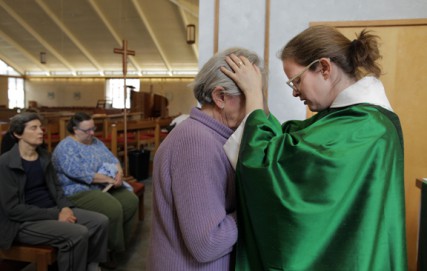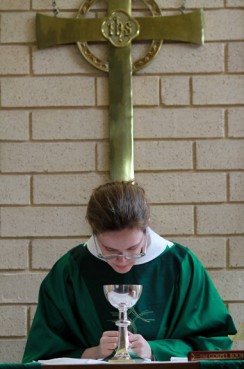For me, a new Lauren Winner book is like Christmas. Her memoirs Girl Meets God and Still have become spiritual classics, and Mudhouse Sabbath — her book on spiritual disciplines like fasting, prayer, and Sabbath – is one of my go-to resources for going deeper in the spiritual life.
She’s a professor at Duke Divinity School, a part-time vicar at a small country church, and a popular writer and retreat leader. (In other words, just your basic slacker.)
Her most recent book Wearing God: Clothing, Laughter, Fire, and Other Overlooked Ways of Meeting God just came out in paperback, so this seems like a great time to talk with Lauren for the blog. Probably a lot of my core Mormon readers don’t yet know her work, and that this particular book, which delves into the familiar and unfamiliar metaphors the Bible uses to talk about God, would be a perfect entry point. — JKR
RNS: The Bible tries over and over again to tell us what God is like by comparing God to objects or situations we know. Why did you want to do a book about this?
Winner: The book isn’t just about overlooked biblical tropes for God, but everyday, ordinary quotidian tropes. To me the most important work of the book is that I’m hoping that it might help people who, like me, don’t always have the liveliest or most consistent relationship with Scripture. The way that God chose to reveal Godself to us in the Scriptures was by drawing on these totally ordinary things like clothing or food.

Duke Divinity School professor and author Lauren Winner prays with Frances Sheve, center, during services at St. Luke’s Episcopal Church in Durham, NC.
RNS: What kinds of images of God surprised you?
Winner: Two things were most surprising to me. There’s a chapter on God as one who perceives scent. When the Bible talks about sensory perception — about a character seeing or smelling — there’s usually a lot more going on than meets the eye. I argue in the book that when God is described as smelling something, as perceiving scent, there’s often a clue in the text to God’s emotional life. Often when God smells an incense offering, for example, God is actually being calmed–it’s sort of biblical aromatherapy–and in God’s new calmness, God becomes more available to a moment of intimate encounter with the people who offered the incense.
Second was the chapter on laughter. When I decided to investigate laughter in the Scriptures, I was kind of hoping that God would be laughing in a happy or humorous way. But actually when God laughs in the Bible it’s a mean and caustic laughing at, not a laughing with. God can laugh at God’s enemies because God knows the enemies won’t win in the end.
This wasn’t what I was looking for, so it led me to do a bunch of research into the relationship between laughter and justice. This was most surprising.
RNS: What images were the most meaningful for you?
Winner: There is a whole chapter on bread and wine. Those are such obvious and ubiquitous images for God, some of our most familiar tropes, but we don’t always think about all the things those images might mean.
Rock is another often used image, and we think of it as foundational and steadfast. But in the scriptures “rock” is used to communicate much more than that. There are several other primary meanings, like in the Song of Moses in Deuteronomy. One of the lines there is that God is like a pregnant rock. It’s a fascinating bit, that we refer to God as a rock all the time. Rarely if ever do we think of God as a rock that is pregnant, a rock that has given birth to us.

Duke Divinity School professor and author Lauren Winner celebrates the Eucharist at St. Luke’s Episcopal Church in Durham, NC.
RNS: Which images were the most fun?
Winner: You know, fun is not really my category. Because of course what I want to tell you about is what I loved researching. I can’t imagine that’s what you want to know about.
RNS: It totally is. I know that “fun” for you is nerdy and geeky and all about the research.
Winner: OK. One is that I write about self-immolation in the fire chapter, about self-immolation and protest in Vietnam. That was fascinating, trying to make sense of the witness of a burning body. This is not something that happens often in the American landscape, but there are these seminal moments where people sometimes still self-immolate in protest. How is that body like a burning bush in its ability to arrest our attention?
RNS: Thinking about God choosing to become manifest in the burning bush is interesting, and the symbolism of fire makes me realize how literal we often are in our approach to Scripture. How do most Americans read the Bible?
Winner: Do most Americans read the Bible at all? I think – you know better than I – that there are long historical Scottish Common Sense roots for reading the Bible in a selectively literalistic way, a prooftexting way. Sometimes we’re inclined to say that this is what “conservative” readers do, but liberal readers do it too.
A less polemical way to say it would be that everyone has a canon that they read, and we all take certain passages of the Bible and make that a lens through which we read the rest of the Bible. That’s probably inevitable. But when it comes to the topic of images for God, it does seem to me that we’re cutting ourselves off from a beautiful witness of the multi-voiced nature of scripture.
Particularly, with reference to images of God, we all know on some level that we can’t actually, finally, give expression to who God is in our language. We will always fall short. Yet at the same time the biblical writers are always stretching and grasping to find ways to express who they think God is and who they think themselves to be in God’s presence.
RNS: How has your book been received in the year since it’s been out?
Winner: To the extent that I have access to how people are responding, I think the concluding chapter is the one that has really gotten people’s imaginations fired up. When I hear from people, what I see happening is that it’s not exactly that they look at scripture differently, but that they start looking around themselves at ordinary things – clothing, a loaf of bread, a tree – all objects that God uses in scripture to tell us more about who he is.
In Scripture, God tells us that Jesus is clothing, so you start looking at clothing differently. And in Hosea, God is likened to a tree, and then you look out your kitchen window and notice a tree in a new way. What does it mean to say that God is like that tree?
My hope for this book has never been to convert people to my five or six favorite God metaphors. It’s been to provoke curiosity, both about things in the scriptures that we haven’t noticed before, and also how to see the world as a bearer of clues about God. This is what Jesus did in the parables – to take ordinary things like a woman kneading her bread or whatever – and say that they aren’t just ordinary, but ways of seeing God. This is a strategy with a two-thousand-year pedigree.
It’s a much more interesting way to go through a day in the universe, I think.






